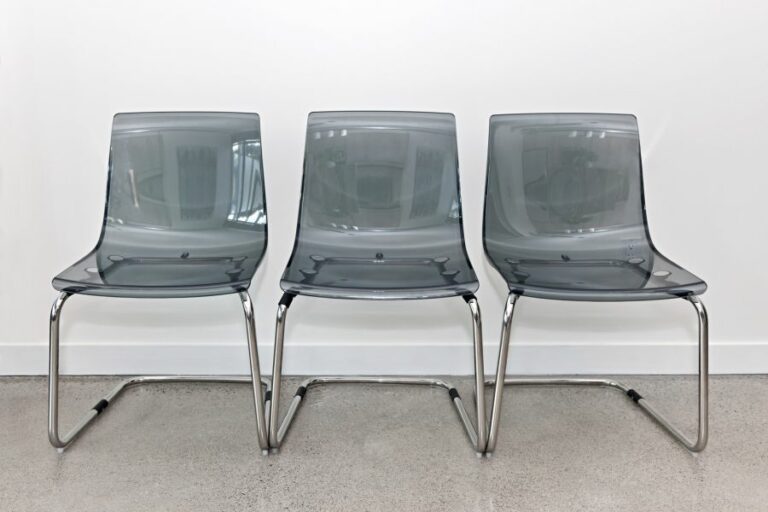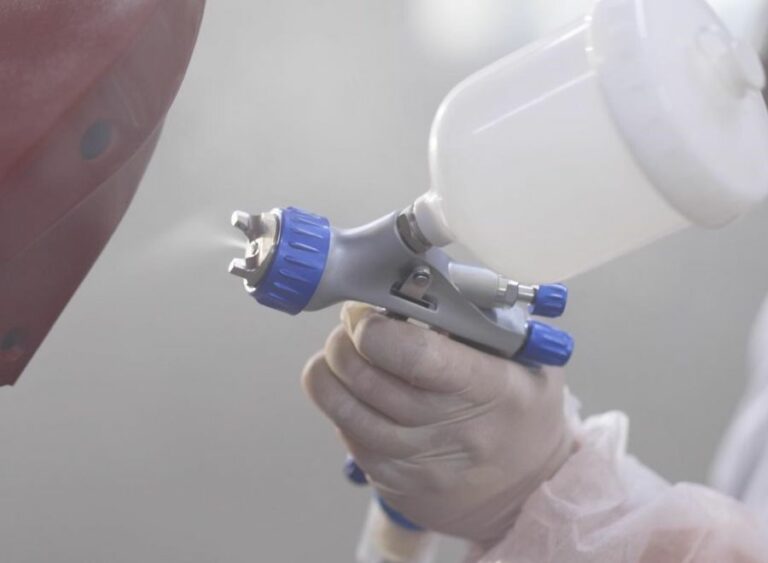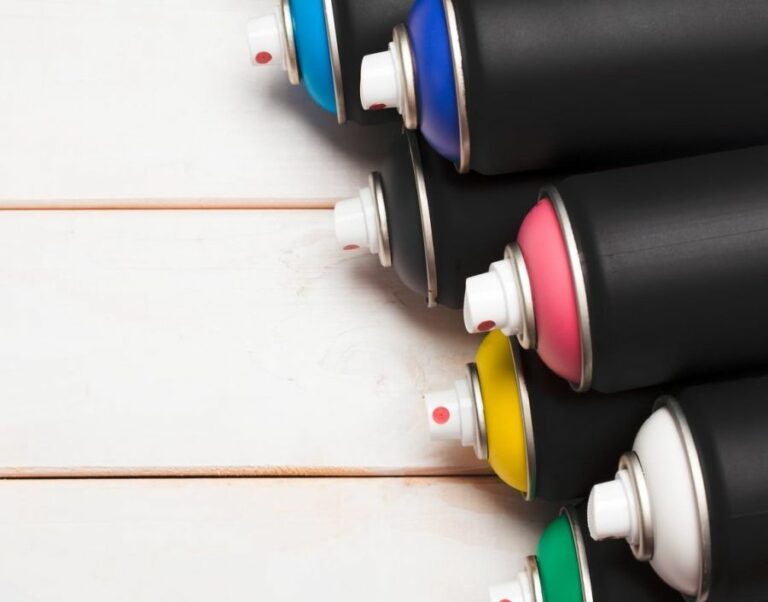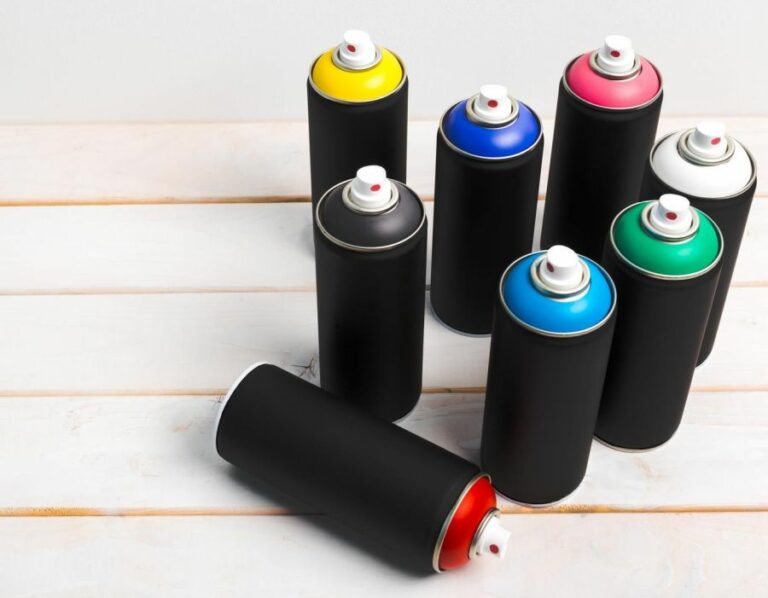Essential Tools & Tips For Painting Plastic Surfaces
If you’ve ever struggled with painting on plastic, you’re not alone! However, with the right tools and tips, your project can end up with a professional look. We’re here to guide you through the essential steps for successful and durable paint application on plastic surfaces. From proper preparation to the choice of paint types and applying techniques, we’ve got you covered.
Essential tools & tips for painting plastic surfaces:
To paint plastic surfaces effectively, use specific paint for plastic (e.g., Krylon Fusion or Rust-Oleum Painter’s Touch Ultra Cover). Prepare the surface by cleaning, sanding, and priming. Use proper painting tools like synthetic bristle brushes, short nap rollers, spray paints, and painter’s tape. Apply multiple thin coats, maintain consistent strokes, and allow sufficient drying time. Finish with a compatible clear sealer for protection.

Discover our essential tools and tips for painting plastic surfaces like a pro! From choosing the right type of paint to expert application techniques, we’ve got you covered. Don’t miss a stroke. Read on to achieve impeccable results on your next plastic painting project.
Contents
- 1 Crucial Techniques & Equipment for Painting Plastic
- 2 Must-Have Instruments for Success
- 3 Necessary Tools: What Do You Need?
- 4 Top Indispensable Tool: A Guide
- 5 The Ultimate Tool Every Man Should Own
- 6 Toolbox Essentials: What Everybody Needs
Crucial Techniques & Equipment for Painting Plastic
Painting plastic surfaces can be a challenging task due to the nature of the material. However, with the right tools, preparation, and techniques, it is possible to achieve a professional and long-lasting finish.
• Choose the Right Paint for Plastic
To ensure proper adhesion and a durable finish, it’s crucial to select the right paint for your project. Most plastic surfaces require a specific paint formulated for plastic, such as Krylon Fusion All-In-One or Rust-Oleum Painter’s Touch Ultra Cover.
For polycarbonate or other rigid plastic materials, consider using acrylic or enamel paints, which are compatible with these types of plastics.
• Proper Surface Preparation
To achieve a smooth and long-lasting finish, it’s essential to properly prepare your plastic surface before painting. Here are some key steps you should follow:
– Cleaning the Surface
Before applying paint, make sure to thoroughly clean the plastic surface using a mild detergent or soap and water. This will remove any dirt, grease, or oils that may prevent the paint from adhering.
– Sanding the Surface
To help the paint bond better to the plastic surface, use fine-grit sandpaper (such as 400 or 600 grit) to lightly sand the plastic. This will create a slightly rough texture, which will enable the paint to grip more effectively.
– Priming the Surface
Applying a primer before painting the plastic is recommended, as it can improve adhesion and promote a smoother finish. When selecting a primer, it’s important to choose one formulated for plastics, such as Rust-Oleum Specialty Plastic Primer or Krylon Primer.
• Essential Painting Tools
To achieve the best results when painting plastic surfaces, it’s important to use the right tools for the job. Here are some essential tools you’ll need:
– Paintbrushes
Select high-quality brushes specifically designed for use with your chosen paint type. Synthetic bristles are particularly well-suited for acrylic and other water-based paints, while natural bristle brushes are recommended for oil-based enamels.
– Paint Rollers
For larger plastic surfaces, using a paint roller can be an efficient and effective method of applying paint. Choose a roller with a short nap (1/4-inch to 3/8-inch) for the smoothest finish.
– Spray Paint
Many paints formulated for plastic surfaces are available in spray cans, which can provide even and efficient coverage. Using spray paint can also help minimize brush strokes and create a more professional finish.
– Painter’s Tape
Using painter’s tape to mask off areas you don’t want to be painted is essential for clean lines and a professional look. Be sure to select a tape that is specifically designed for the task, such as FrogTape Multi-Surface or ScotchBlue Original Painters Tape.
• Painting Techniques for Plastic Surfaces
To achieve professional-looking results, it’s essential to use proper painting techniques when painting plastic surfaces. Here are some tips to keep in mind:
– Thin Coats
Apply multiple thin coats of paint, allowing each coat to dry fully before applying the next. This will help prevent drips, runs, and sagging and will promote even coverage.
– Maintain a Consistent Stroke
When using a paintbrush or roller, maintain a consistent stroke pattern to avoid uneven coverage and visible brush strokes.
– Use a Spray Paint Gun
If using spray paint, consider investing in a spray paint gun to achieve a more even and controlled application. Some popular options include the Wagner Spraytech and Graco Magnum series.
– Allow Proper Drying Time
Take care to allow sufficient drying time between coats as well as after the final coat. This will help prevent tackiness and promote a more durable finish.
• Sealing the Paint
After your paint has fully dried, apply a clear sealer or topcoat to help protect it from wear, UV exposure, and other environmental factors. Choose a sealer compatible with the type of paint you used and follow the manufacturer’s instructions for application.
By following these essential tools and tips, you can successfully paint plastic surfaces and achieve a professional, long-lasting finish. With the proper preparation, tools, and techniques, painting plastic can be a rewarding and transformative project.
Must-Have Instruments for Success
• Essential Tools for Home Improvement
Home improvement tasks often require the use of various tools to ensure optimal results. Here are some essential tools for home improvement tasks:
– Measuring Tools
- Tape Measure: A tape measure is crucial for obtaining accurate measurements while working on a project. It can help ensure that materials fit correctly and that construction is precise. (I recommend using a 25-ft retractable tape measure.)
- Level: A level ensures that surfaces are even and plumb, preventing issues with alignment and stability. There are various types of levels, such as spirit levels and laser levels. (I recommend using a 48-inch spirit level for most home improvement projects.)
– Cutting Tools
- Utility Knife: A utility knife is an indispensable tool for cutting various materials, such as drywall, roofing material, and insulation. (I recommend using a retractable-blade utility knife for easy blade changes and optimal safety.)
- Handsaw: A handsaw is useful for making quick, rough cuts in wood and other similar materials. (I recommend using a 15-inch general-purpose handsaw with a comfortable grip.)
- Circular Saw: For more precise and efficient cuts in wood, a circular saw is a worthwhile investment. (I recommend using a cordless circular saw with a 6-1/2 inch blade for optimal portability and convenience.)
– Fastening Tools
- Screwdriver Set: A screwdriver set with various sizes and types of tips is essential for assembling, disassembling, and adjusting various components. (I recommend purchasing a set that includes both flathead and Phillips screwdrivers in multiple sizes.)
- Drill and Driver: A power drill with a driver attachment is valuable for quickly and efficiently driving screws and drilling holes in various materials. (I recommend investing in a cordless 18-volt drill/driver with a lithium-ion battery for optimal performance and convenience.)
- Hammer: Essential for driving nails and other fasteners, a hammer is necessary for nearly all home improvement tasks. (I recommend using a 16-ounce claw hammer for a good balance of power and ease of use.)
- Wrench Set: A wrench set is valuable for tightening and loosening nuts and bolts in various applications. (I recommend purchasing a set that includes both metric and SAE sizes.)
– Safety Equipment
- Safety Glasses: Protective eyewear is vital for preventing eye injuries while working with tools and materials. (I recommend using ANSI-rated safety glasses for optimal protection.)
- Work Gloves: Work gloves protect your hands from cuts, scrapes, and blisters while handling tools and materials. (I recommend using gloves with a reinforced grip for added durability and control.)
- Hearing Protection: When using loud power tools, it is essential to protect your hearing with earmuffs or earplugs. (I recommend using noise-canceling earmuffs for optimal comfort and effectiveness.)
For more information on essential home improvement tools, check out Family Handyman.
• Essential Tools for Automotive Repair
Maintaining and repairing a vehicle requires a specific set of tools to ensure efficient and successful work. Here are some essential tools for automotive repair:
– Basic Hand Tools
- Socket Set: A socket set with various metric and SAE sizes is necessary for removing and tightening nuts and bolts on a vehicle. (I recommend investing in a quality set with a ratchet and extensions.)
- Wrench Set: Similar to the wrench set discussed for home improvement, a quality set with both metric and SAE sizes is crucial for automotive work.
- Screwdriver Set: As with home improvement, a good screwdriver set with various sizes and types of tips is essential for automotive repair.
- Pliers: Needle-nose and regular pliers are valuable for gripping, bending, cutting, and manipulating various automotive components. (I recommend using 8-inch needle-nose and 10-inch tongue-and-groove pliers.)
– Specialized Automotive Tools
- Oil Filter Wrench: An oil filter wrench is necessary for changing the oil in a vehicle, as it helps to remove and tighten oil filters. (I recommend using a strap-style oil filter wrench for versatility with various filter sizes.)
- Torque Wrench: A torque wrench ensures that nuts and bolts are tightened to the correct specifications, preventing damage or failure. (I recommend using a 1/2-inch drive torque wrench with a range of 30 to 150 ft-lbs.)
- Jack and Jack Stands: Lifting a vehicle off the ground requires a sturdy jack, and supporting the vehicle securely while working underneath requires jack stands. (I recommend using a floor jack and jack stands with a combined weight capacity that exceeds the vehicle’s weight.)
– Diagnostic Equipment
- OBD-II Scanner: An OBD-II (On-board Diagnostics-II) scanner is useful for diagnosing issues with a vehicle’s engine control module and other onboard systems. (I recommend an OBD-II scanner that also reads ABS and airbag system codes for a comprehensive diagnostic tool.)
- Multimeter: A multimeter is an essential tool for diagnosing electrical issues within a vehicle, such as shorts, power draws, and continuity. (I recommend a digital multimeter with auto-ranging capabilities for added ease of use.)
For more information on essential automotive repair tools, visit CarCare.org.
Maintaining a well-stocked toolbox with essential tools for various tasks can significantly improve one’s ability to effectively tackle home improvement and automotive repair projects. With the right tools and knowledge, many common tasks can be handled proficiently and safely.
Necessary Tools: What Do You Need?
No matter what industry or profession you are in, having the right tools can make your job easier and more efficient.
• Hand Tools for Everyone
– Hammers
The most basic and versatile tool in any toolbox is the hammer. There are various types of hammers for different purposes, but a 16-ounce claw hammer is the most common choice for everyday use. This type of hammer is perfect for driving nails or small demolition tasks.
A good hammer should have a comfortable grip and a well-balanced head.
– Screwdrivers
A set of screwdrivers is essential for any toolbox. It is recommended to have a variety of sizes and types, including flathead, Phillips, and Torx. It’s also helpful to have a screwdriver with interchangeable bits for added versatility. Look for screwdrivers with non-slip handles and quality metal construction to ensure durability and longevity.
– Pliers
There are several types of pliers that are useful for various tasks, making them an essential addition to your toolbox. Needle-nose pliers are great for precision work, while groove-joint pliers can provide a broader range of uses due to their adjustable width. For electrical work, having wire strippers is also essential.
– Wrenches
A good set of wrenches can help you tackle tasks requiring more torque than a screwdriver can provide. The two most common types of wrenches are the adjustable wrench and the combination wrench. Adjustable wrenches can be adjusted to fit a variety of nuts and bolts, while combination wrenches have both open and box ends for added versatility. For best results, invest in a set that includes both metric and imperial sizes.
• Power Tools for DIY Enthusiasts
While hand tools are essential for every toolbox, those who frequently tackle DIY projects may also want to invest in some power tools. These tools can make tasks quicker and easier, especially for larger projects.
– Drill
A cordless drill is an invaluable tool for a wide range of tasks, from hanging shelves to assembling furniture. Look for a drill with multiple speed settings and a selection of drill bits for various materials. Additionally, consider choosing a drill with a built-in LED light for improved visibility in tight spaces.
– Circular Saw
For cutting large pieces of lumber or plywood, a circular saw can save time and deliver precise cuts. Look for a saw with a sturdy base plate and a powerful motor. It’s also essential to have the appropriate blades for various materials, such as wood, metal, and masonry.
– Jigsaw
A jigsaw is an excellent versatile cutting tool that can handle curved and intricate cuts. Ensure the jigsaw has variable speed control and a comfortable grip. As with the circular saw, having the proper blades for different materials is crucial.
– Sander
Whether you’re refinishing furniture or smoothing out rough edges, a good orbital sander can save time and provide a uniform finish. Look for a sander with variable speed control, and make sure to have a selection of sandpaper grits for different surfaces.
• Safety and Measuring Tools
Regardless of what tools you use, ensuring proper safety and accurate measurements is essential for any project.
– Tape Measure
A quality tape measure is indispensable for accurately measuring materials and distances. Choose a durable tape measure that is easy to read, with a lock and recoil mechanism for convenience.
– Level
A level is needed to guarantee that your work is straight and level. Opt for a longer level for larger projects, and consider adding a smaller torpedo level for tight spaces or smaller tasks.
– Protective Gear
Safety should always be a priority when working with tools. Make sure to have safety glasses, work gloves, and hearing protection when needed. Additionally, invest in a first-aid kit for your toolbox, in case an accident occurs.
• General Maintenance and Organization Tools
Finally, proper maintenance and organization can ensure your tools last longer and are easy to access when needed.
– Toolbox or Tool Bag
Choose a toolbox or tool bag that accommodates your tools and is portable enough for your needs. Look for a box with compartments for better organization, or opt for a tool bag with multiple pockets and loops.
– Cleaning Supplies
Keep your tools in good working order by occasionally cleaning them with a soft brush, rags, and lubricating oil. Taking care of your tools helps extend their longevity and ensures they perform well when needed.
In conclusion, having the right set of tools and maintaining them well is essential for tackling various tasks and projects confidently. With these essential tools in your toolbox, you’ll be better equipped to handle any job that comes your way.
Tool | Description |
|---|---|
Hammer | Used for driving nails, breaking objects, and more. |
Screwdriver | Used to turn screws and other threaded fasteners. |
Wrench | Used to provide grip and mechanical advantage in turning nuts and bolts. |
Pliers | Used for gripping, holding, and cutting various objects. |
Tape Measure | Used to measure size or distance. |
Utility Knife | Used for cutting and trimming various materials. |
Level | Used to ensure that surfaces are horizontally or vertically level. |
Flashlight | Used to provide light in dark spaces, for safety and convenience. |
Top Indispensable Tool: A Guide
When discussing the concept of an essential tool, it is crucial to focus on the virtues that make it fundamental and indispensable.
• Versatility: A Key Feature of Essential Tools
An elemental characteristic of an essential tool is its versatility. The tool must excel at various tasks, showcasing its adaptability in different environments and conditions. A tool’s capacity to tackle multiple tasks diminishes the need for additional tools and enhances its value.
In terms of versatility, the multitool stands out as a perfect candidate. The multitool is a compact, portable device integrating several different tools, such as pliers, screwdrivers, knives, and scissors, among others. A prime example is the popular Swiss Army Knife.
• Durability and Reliability: Foundations of a Trustworthy Tool
The primary responsibility of an essential tool is to withstand the test of time, tackling wear and tear caused by regular usage. An essential tool should possess robust construction and materials to ensure its durability and reliability.
The hammer serves as a shining symbol of durability in the world of tools. With a simple yet robust design, hammers have been used for centuries for a wide array of construction and work purposes. Most hammers feature a solid metal head and a strong handle, often made from fiberglass or wood.
This sturdy design ensures the hammer’s longevity and trustworthiness in various settings.
• Accessibility: Making the Essential Tool Available to Everyone
An essential tool must be readily available and accessible to both professionals and amateurs alike. By maintaining a reasonable price point and widespread availability, the tool can reach a larger audience, making it indispensable for many users.
The screwdriver fits the bill for accessibility in the essential tool category. With a simple design combining a handle and a metal shaft with a specific tip (flathead or Phillips), screwdrivers serve as indispensable components in many repair and assembly tasks.
Their availability at nearly all hardware stores and the variety of sizes and types make them a top contender for the essential tool.
• Ease of Use: Simplifying Tasks for the User
An essential tool should provide users with a sense of ease and simplicity in operation, reducing the learning curve and allowing for efficient completion of tasks. Additionally, it should be ergonomic, minimizing the strain on the user’s body during extended periods of use.
The tape measure is an excellent example of an easy-to-use tool. Its retractable design allows for quick measurement of objects and surfaces, while its standardized markings facilitate accurate readings.
The locking mechanism and ergonomic grip also enhance the user’s experience while utilizing this essential tool.
• Bringing It All Together: The Essential Tool
Taking all of these criteria into consideration, the multitool emerges as the most essential tool. Its versatility, durability, accessibility, and ease of use make it an invaluable addition to any toolbox or workshop.
Fusing multiple functionalities within a compact design, the multitool proves highly efficient in various situations, accommodating amateurs and professionals alike.
To fully harness the power of the multitool, I recommend investing in a high-quality, reputable brand like Leatherman or Victorinox. A well-constructed multitool will offer longevity and consistent performance, as well as ensure that each tool integrated within it is of superior quality.
I also advise becoming familiar with each tool in the multitool, understanding its specific functionality, and mastering its usage. This acquired knowledge will empower users to tackle various tasks with ease, truly making the multitool an essential resource.
We trust that this comprehensive guide to the essential tool has provided valuable insights to both casual and experienced tool enthusiasts. By acknowledging the unique features and qualities of the multitool, users can reap the benefits and embrace this indispensable device in their daily lives.
The Ultimate Tool Every Man Should Own
We will discuss the must-have tools that every man should have in his toolbox. These tools come in handy for various purposes, from simple repairs to more complex DIY projects. By equipping your toolkit with these essential tools, you will be prepared to tackle any task that comes your way.
• High-Quality Hammer
A quality hammer is an indispensable addition to any toolbox. This versatile tool is used for driving nails, breaking materials, and other general-purpose applications. While selecting a hammer, make sure to choose one with a comfortable grip and sturdy construction.
The Estwing E3-16C hammer is a popular choice due to its durability and balanced weight distribution.
• Trustworthy Screwdriver Set
A comprehensive screwdriver set is a must-have for every toolbox. It is important to have a variety of screwdriver types, including flathead, Phillips, and square (Robertson) to accommodate different screw configurations.
Additionally, a good set should include screwdrivers in various sizes to handle both small and large tasks.
• Pliers for Various Tasks
Pliers are versatile and essential tool that can be used for gripping, bending, cutting, and stripping wires. Some useful pliers types of having in your toolbox include:
- Long-nose pliers: These pliers are perfect for reaching into tight spaces and handling small parts.
- Diagonal cutting pliers: Also known as wire cutters, these are used for cutting wires, small nails, and other materials.
- Groove joint pliers: With adjustable jaws, these pliers are ideal for gripping various shapes and sizes of objects.
• Sturdy Tape Measure
A reliable tape measure is an absolute necessity for any DIY project or repair. A quality tape measure should have a firm locking mechanism, a sturdy blade, and a durable construction. I recommend going for a 25-foot tape measure, as this length is suitable for most tasks.
• Adjustable Wrench
An adjustable wrench is a versatile tool used for turning various sizes of nuts and bolts. This wrench features an adjustable jaw that can be easily modified to fit different fasteners. I recommend choosing a wrench with a comfortable handle and accurate calibration for easy adjustments.
• Level for Precise Alignment
A level is essential when it comes to checking the alignment of objects, such as hanging shelves, installing cabinets, or hanging frames.
Opt for a high-quality level with a robust construction that guarantees accurate measurements. Levels with magnetic strips are exceptionally useful for working with metal surfaces.
• High-Power Cordless Drill
A cordless drill is a versatile power tool that every man should own. It is perfect for drilling holes and driving screws in various constructions. I suggest going for a high-power cordless drill with multiple speed settings, a comfortable grip, and an excellent battery life.
• Set of Allen Wrenches
Also known as hex keys, Allen wrenches are L-shaped tools used to drive bolts and screws with hexagonal sockets. They are commonly used in furniture assembly and other applications where a standard screwdriver may not fit.
Make sure to have a set of Allen wrenches in both metric and standard sizes.
• Reliable Utility Knife
A utility knife is an indispensable tool for various cutting tasks, such as opening boxes, trimming materials, or cutting cords. Choose a knife with a comfortable grip, sturdy construction, and a replaceable blade to ensure longevity.
• Durable Handsaw
A handsaw is an essential addition to any toolbox for cutting through materials like wood, plastic, and drywall. Opt for a durable handsaw with a sharp blade and a comfortable handle. It might also be beneficial to have both a fine-toothed saw for precise cuts and a coarse-toothed saw for faster cutting.
• Safety Gear
Lastly, it is crucial to have appropriate safety gear for any task you undertake. Essential safety items include:
- Safety glasses: To protect your eyes from debris and particles.
- Work gloves: To shield your hands from sharp objects, chemicals, and other hazards.
- Dust mask: To prevent the inhalation of harmful particles.
In conclusion, having a well-equipped toolbox is essential for every man to effectively tackle various repairs, maintenance tasks, and DIY projects. By ensuring that you have the recommended tools listed above, you will be ready to handle any task that comes your way.
Toolbox Essentials: What Everybody Needs
A well-equipped toolbox is an indispensable resource for any DIY enthusiast, homeowner, or professional tradesperson. Having the right tools on hand can make a world of difference in completing projects successfully and efficiently.
• Measuring and Marking Tools
– Tape Measure
A tape measure is crucial for any project that requires accurate measurements. A 25-foot retractable tape measure is ideal for most situations, as it can handle various distances without being too bulky.
– Carpenter’s Square and Level
A carpenter’s square is useful for drawing straight lines and ensuring that angles are square, while a level ensures that surfaces are perfectly horizontal or vertical. Opt for a 9-inch torpedo level and a 12-inch combination square for maximum versatility.
– Pencils and Markers
Pencils and markers are vital for marking cuts, holes, and other measurements on various materials. A standard carpenter’s pencil paired with a fine-tip permanent marker will tackle most tasks.
• Cutting and Sawing Tools
– Utility Knife
A utility knife is a versatile tool for cutting various materials, including cardboard, paper, and plastic. Opt for a retractable knife with a comfortable grip and easily replaceable blades.
– Handsaw or Hacksaw
A handsaw or hacksaw is necessary for cutting wood, metal, or plastic. A 12-inch hacksaw with spare blades will serve most purposes, while a 15-inch handsaw is ideal for cutting wood.
– Chisels
Wood chisels are useful for carving, shaping, or trimming wood. A set of three chisels in 1/2-inch, 3/4-inch, and 1-inch widths will accommodate a variety of tasks.
• Drilling and Driving Tools
– Screwdrivers
A set of screwdrivers is essential for driving or removing screws. Opt for a versatile set that includes multiple sizes of both flat-head and Phillips-head screwdrivers. Additionally, investing in a ratcheting or multi-bit screwdriver can save time and effort.
– Hammer
A 16-ounce claw hammer is a must-have for driving nails, pulling nails out, and other general-purpose tasks. Ensure the hammer has a comfortable grip and a well-balanced design for ease of use.
– Cordless Drill
A cordless drill is an invaluable tool for drilling holes or driving screws with speed and ease. Choose a reliable brand with at least 12 volts, multiple speed settings, and a comfortable grip. Remember to include an assortment of drill bits and driver bits to tackle various materials and fasteners.
– Wrench Set
A wrench set is essential for tightening or loosening nuts and bolts. A combination wrench set that includes both standard and metric sizes, as well as an adjustable wrench, will cover various needs.
• Gripping and Clamping Tools
– Pliers
Pliers are crucial for gripping, bending, and cutting various materials. Three essential types of pliers to have in your toolbox are needle-nose pliers, slip-joint pliers, and diagonal-cutting pliers.
– Vise-Grip
A vise-grip, or locking plier, is valuable for holding or clamping objects securely. Choose a 10-inch curved-jaw model for maximum versatility.
– C-Clamps or Bar Clamps
Clamps are indispensable for holding objects tightly together during tasks like gluing or nailing. A couple of 4-inch C-clamps or bar clamps will serve most purposes.
• Finishing Tools
– Sandpaper and Sanding Block
Sanding is a vital aspect of most woodworking, painting, and other finishing tasks. Keep an assortment of sandpaper grits and a sanding block on hand for various applications.
– Putty Knife
A putty knife is a multi-purpose tool useful for scraping, spreading filler, or removing excess material. Opt for a 1 1/2-inch flexible blade for maximum versatility.
– Paintbrushes and Rollers
Good-quality paintbrushes and rollers are essential for achieving a smooth, professional finish when painting. Keep a selection of sizes and types on hand for different tasks and paint types.
In conclusion, having a well-equipped toolbox is crucial for tackling various tasks with efficiency and ease. By stocking your toolbox with the essential tools listed in this article, you will be well-prepared for most home repair and improvement projects. Happy DIY-ing!







